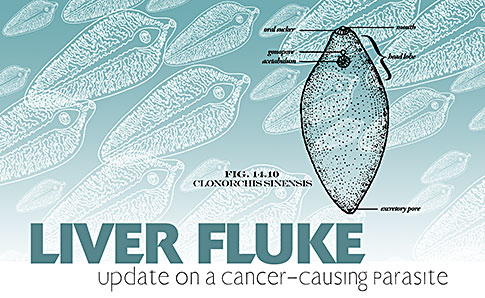 |
|||||||||
|
January/February 2017
BY CLAUDIA GARY “Toxic Hitchhikers” in the March/April 2014 issue reported on parasites from war zones and the illnesses they have caused. One of the most insidious is the liver fluke—Opisthorchis viverrini or Clonorchis sinensis—a freshwater-fish-borne flatworm that causes cholangiocarcinoma (cancer of the bile duct). Cholangiocarcinoma is widespread in areas of Southeast Asia due to the popularity of traditional dishes in which fish is either raw or insufficiently cooked to kill the parasite. Many veterans who served in or near Vietnam acquired the parasite. What makes liver fluke infection especially ominous is that the parasite can live and reproduce in the bile duct for thirty years or longer. This causes chronic inflammation that eventually creates cancerous cells before producing noticeable symptoms. Although detection and elimination of the parasite are easy at an early stage, all too often the infection is not discovered until a patient has Stage IV cancer. Typically, the first visible signs include jaundice resulting from a blocked bile duct. At this stage, the prognosis is dismal, and the same cancerous blockage that causes jaundice also locks in a still-thriving colony of liver flukes, preventing their detection in stool samples. Liver flukes often cannot be detected by the usual method, because they are sealed into the bile duct. A non-invasive test is being developed that would detect liver fluke infection by determining species-specific antigens in the urine. This is described in a 2016 article from Thailand, published in the journal PLOS Neglected Tropical Diseases. All in-country Vietnam veterans are encouraged to get tested for liver flukes before cancer symptoms appear. In the worst cases, the test would provide survivors with the information to help prove service connection when applying for VA benefits. Unfortunately, lack of information and the resultant confusion about this cancer have continued to obstruct such claims, making them more difficult for veterans and their families. Today, the evidence and explanation are clear and widely available. Several informative and accessible articles are listed below. These range from scholarly papers to information published by nonprofit organizations such as the American Cancer Society, as well as government agencies. See also the March/April 2014 issue of The VVA Veteran for additional information. Recent studies have focused on increased awareness, education, cancer treatment, and early diagnostic methods. The National Institutes of Health reprinted a 2011 article from the Korean Journal of Radiology, “Liver Flukes: The Malady Neglected,” by Jae Hoon Lim, MD. The National Cancer Institute of the NIH provides treatment information and a useful illustration of the bile ducts and their connections. The American Cancer Society has a thorough and informative article on cholangiocarcinoma. The Cleveland Clinic is clear about risk factors. Smithsonian magazine published this article about liver flukes and bile duct cancer in 2009. Dr. Paul Brindley, whom we interviewed early in 2014 about how liver flukes cause cholangiocarcinoma, co-authored an article later that year. Brindley also provided this article from Khon Kaen University in Thailand, which describes public health programs and advances in cholangiocarcinoma treatment and diagnosis in an area of Southeast Asia where it is endemic. The Centers for Disease Control describes and illustrates the life cycle of the liver fluke and its connection to cholangiocarcinoma here. For anyone who has traveled to Southeast Asia and eaten local food but has no symptoms, testing is worthwhile and simple. It can be done through the VA or a private physician. If liver fluke infection is detected, it is easily treated using guidelines from CDC. |
|||||||||
|
|
|||||||||
The Military Working Dog Commemorative Stamp Drive needs your help. |
|||||||||
8719 Colesville Road, Suite 100, Silver Spring. MD 20910 | www.vva.org | contact us |
|||||||||





















